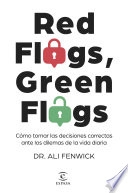

The book discusses the significance of cultivating healthy relationships, whether in the workplace or personal life. It outlines strategies for building trust and open communication, which are vital for identifying red and green flags. Healthy relationships are characterized by mutual respect, understanding, and a willingness to address conflicts constructively. By focusing on relationship-building, individuals can create environments that are conducive to collaboration and innovation.
Continue readingRed flags are indicators of potential problems or risks in various contexts, including business, relationships, and personal decisions. Recognizing these warning signs early can prevent larger issues down the line. The book emphasizes the importance of being vigilant and aware of these signals, which can manifest in various forms such as poor communication, lack of transparency, or inconsistent behavior. By identifying red flags, individuals and organizations can take proactive measures to address issues before they escalate, leading to healthier relationships and more robust business practices.
Continue readingIn contrast to red flags, green flags signify positive attributes or behaviors that indicate a healthy environment or relationship. These can include clear communication, mutual respect, and a demonstrated willingness to collaborate. The book highlights the importance of recognizing these positive signals, as they can foster trust and encourage productive partnerships. By focusing on green flags, individuals can cultivate environments that promote growth and success, whether in personal relationships or professional settings.
Continue readingSelf-awareness is a crucial theme in 'Red Flags, Green Flags.' The book argues that understanding one's own values, strengths, and weaknesses is essential for recognizing red and green flags in others. By developing self-awareness, individuals can better navigate their interactions and relationships, leading to more informed decisions. This concept is particularly relevant for leaders and entrepreneurs, who must be attuned to both their own behaviors and those of their teams to create a positive organizational culture.
Continue readingA key takeaway from the book is the establishment of a decision-making framework that incorporates the identification of red and green flags. This framework encourages individuals to assess situations critically and make informed choices based on the signals they observe. By applying this framework, readers can enhance their decision-making skills, leading to better outcomes in both personal and professional contexts. The book provides practical examples and scenarios to illustrate how this framework can be applied effectively.
Continue readingThe book addresses the inevitability of challenges in both personal and professional spheres. It emphasizes that recognizing red flags can help individuals navigate these challenges more effectively. By being aware of potential pitfalls and taking proactive measures, individuals can mitigate risks and enhance their resilience. The discussion includes strategies for overcoming obstacles and maintaining a positive outlook, even in the face of adversity.
Continue readingEffective communication is a central theme in 'Red Flags, Green Flags.' The book highlights how communication styles can serve as both red and green flags. Poor communication can signal underlying issues, while clear, open dialogue can indicate a healthy relationship. The author provides insights into improving communication skills, such as active listening and providing constructive feedback, which are essential for fostering positive interactions and identifying potential problems early.
Continue reading